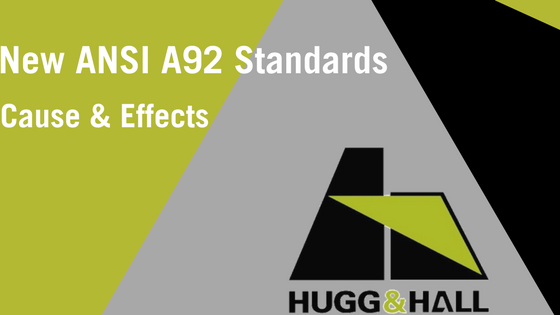
The Cause and Effects of the New ANSI A92 Standards
Big changes have been announced for the regulation of certified boom and scissor type platform machines. ANSI has announced new standards that will affect rental fleets, rental customers and operators. The new ANSI A92 standards will include A92.22 for safe use, A92.20 for design and A92.24 for training. The new standards are replacing prior ANSI standards A92.3, A92.5, A92.6 and A92.8 which covered manually propelled aerial, booms, scissors and under-bridge inspection machines. The standards dictate stability, testing and safety requirements to manufacturers so that consumers are provided certified and safe machines.

Hugg & Hall has assembled further information to expand on our prior article regarding these changes in order to assist with the education and implementation of the new standards. Hugg & Hall hopes this will help with the adaptation and education of the new ANSI changes.
The Cause of the Standards
ANSI and their Canadian counterpart, the Canadian Standards Authority (CSA), are moving toward equipment design standards that will bring North American equipment up-to-date with the current standards implemented in Europe to reduce global variances in the industry.
Some Changes & Effects Associated With the Standards
Terminology
Much of the prior compliance terminology, as used for training purposes, will be updated. There will be 31 new definitions and 15 changes to prior definitions. A significant change to the standard terminology is the update of Aerial Work Platforms (AWP) to Mobile Elevating Work Platforms (MEWP). Another relevant update will be the use of the term “operation manual” versus the prior used “operator’s manual.”
An important terminological methodology change will be the use of groups and types to define MEWP categories. For example, “Group A” will be used to define MEWPs with vertical platforms. “Group B” will be used to define booms. Examples of the use of types of MEWPs include: “Type 1” to define static MEWPs, “Type 2” to define mobile from ground control MEWPs and “Type 3” to define mobile from platform MEWPs. Type and group terminology can be combined to further define MEWPs. For example, “1A” can be used to describe a vertical platform, static MEWP.
Platform Load Sensing
Perhaps the most notable change to prior ANSI A92 standards is the new requirement of load sensing on aerial equipment. The prior standard required the machine operator to ensure that the machine was not loaded beyond capacity, as communicated by the manufacturer. The new standard requires manufacturers to incorporate load sensing technology on each machine which restricts overloading by disabling elevating functions when overloaded. The load sensing device will sound an alarm when overloaded and disable some functions of the machine to prevent unsafe use.
Scissor lifts are expected to be modified to generally implement the new platform load sensory standard via angle sensors, pressure transducers or load sensing pins. Boom lifts are expected to be modified to generally implement the new standard via load cells.
Wind Force
Another significant adjustment to the prior standards are further regulations regarding wind force. Wind force is assessed more aggressively under the new standards. Though requirements will vary for each machine, standards for scissors and vertical masts have more drastic updates due to having narrower slab units. Some units previously cleared for outdoor use may be re-organized as indoor-only machines due to unsafe wind force ratings. Boom lifts may be required to adjust/add weight for safe use in regards to wind force, but should be less affected than scissors and vertical masts.
Dynamic Terrain Sensing
Prior standards have been updated to include terrain sensing so drive and boom functions will be disabled if not within safety and terrain/slope limits. Stability calculations have been updated and may, largely, affect the difference between air and foam-filled tires. Due to feasibility issues, foam filled tires are expected to become standard procedure for RT scissors and RT booms.
Railings and Platform Entries
There have been updates to platform railing and entrance gate standards prior to updated A92 standards. Additional height standards for railings on scissors is the new guideline which requires the railings to be foldable as the added height results in scissors no longer fitting through standard door heights.
As well as added height to railings, entrance gates have undergone an update. Flexible devices, such as chains (which were the previous norm), are no longer permitted to be used as platform gates on scissors and toe boards are required to be present on all areas of platforms. This will plausibly result in half height, full height or saloon style gates on scissors. However boom lifts will generally keep the prior standardized gates but, again, toe boards are required to cover the entrance area.
While the financial effects of the new standards are unclear, it’s possible that product prices may increase to adjust features for compliance. However, the full financial effects are unclear at this early-stage.
Back to News
Subscribe and unlock cutting-edge equipment insights, trends and tips!
Subscribe